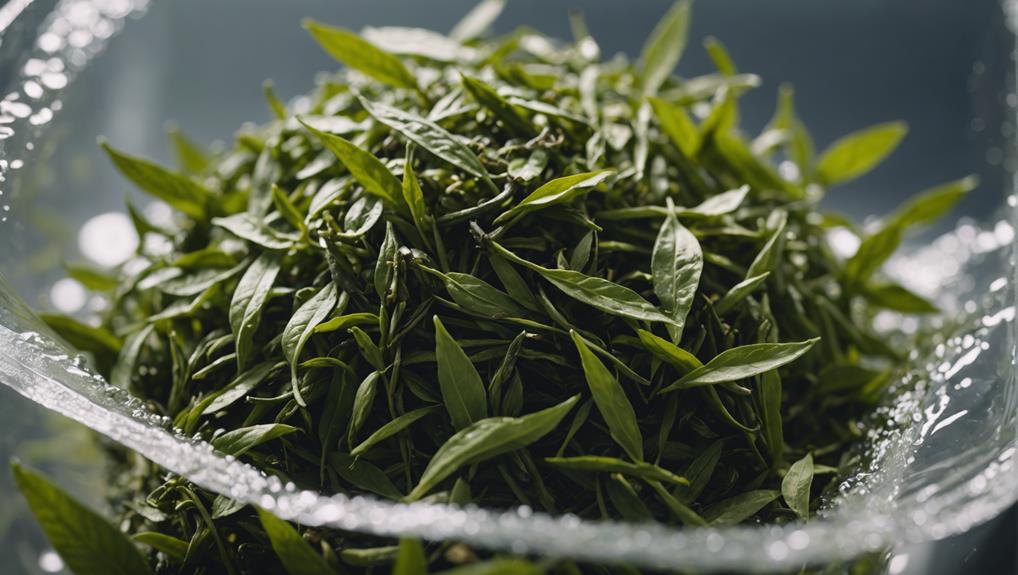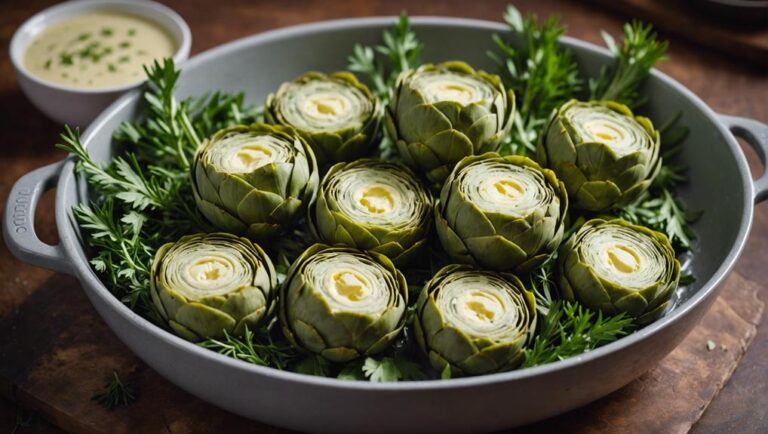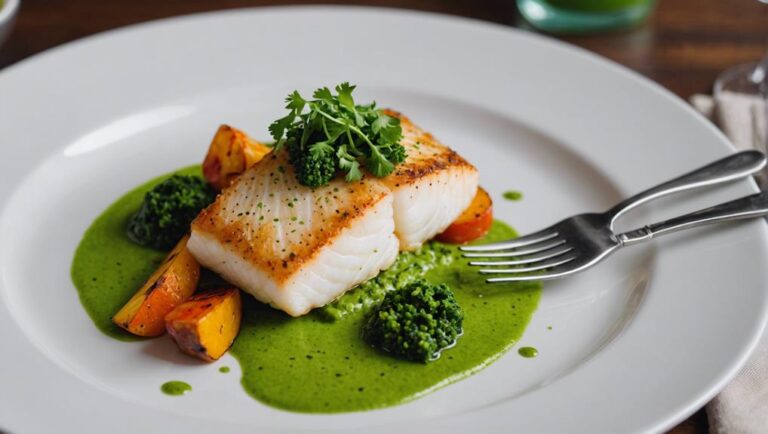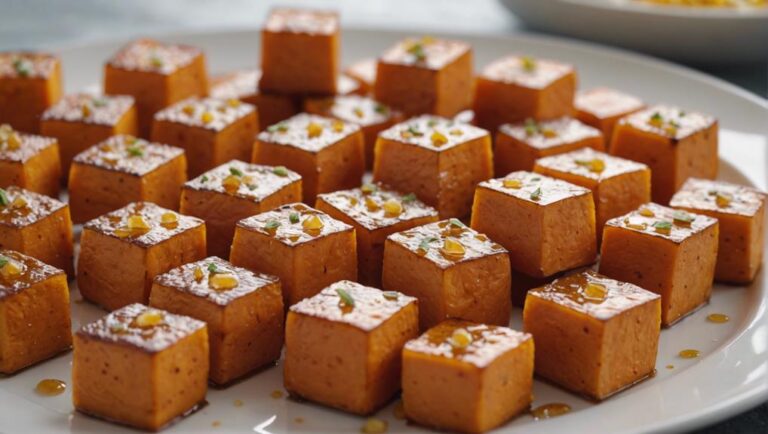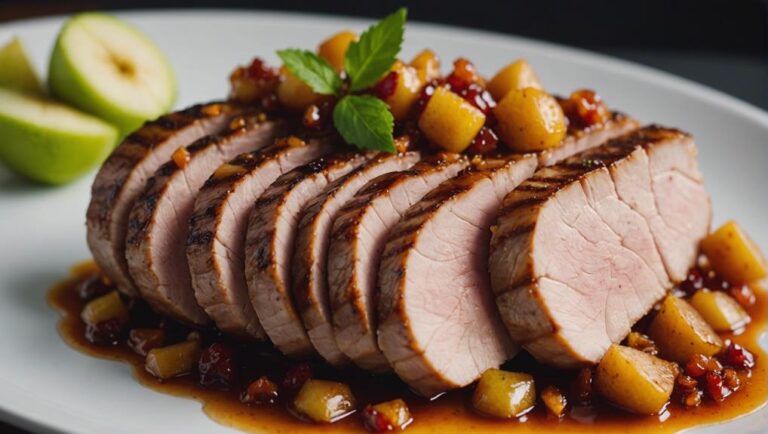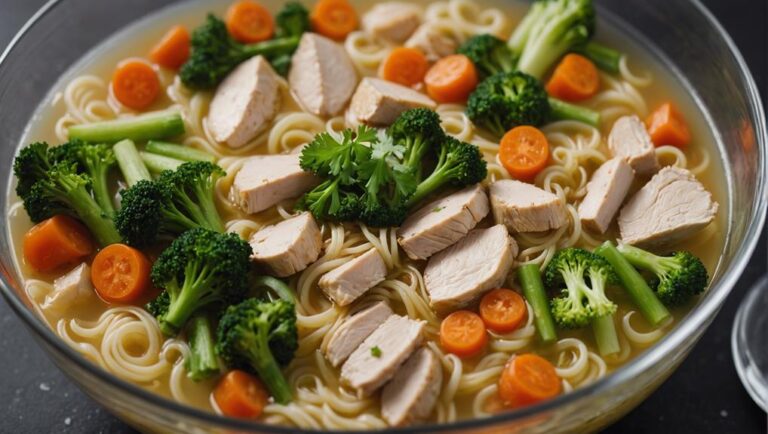Sous Vide Green Tea
Enhance your culinary skills by revealing green tea using sous vide techniques. Achieve precise temperature control for consistent tea infusion. Experiment with various green tea varieties to reveal nuanced flavors. Benefit from the health perks and delicate floral notes of green tea. Elevate your dishes' aromatic profiles with this method. Discover how sous vide can revolutionize the way green tea flavors are incorporated into your recipes. Explore the potential of this technique for a unique and flavorful experience that goes beyond traditional preparation methods. Further insights await on the intricacies of using green tea in sous vide.
What You Will Learn Here
- Precision temperature control enhances green tea infusion.
- Consistent temperatures optimize flavor extraction in sous vide.
- Delicate green tea flavors preserved with even infusion.
- Aromatic profile tailored through temperature and time adjustments.
- Sous vide amplifies green tea's taste and health benefits.
Tea's Origins
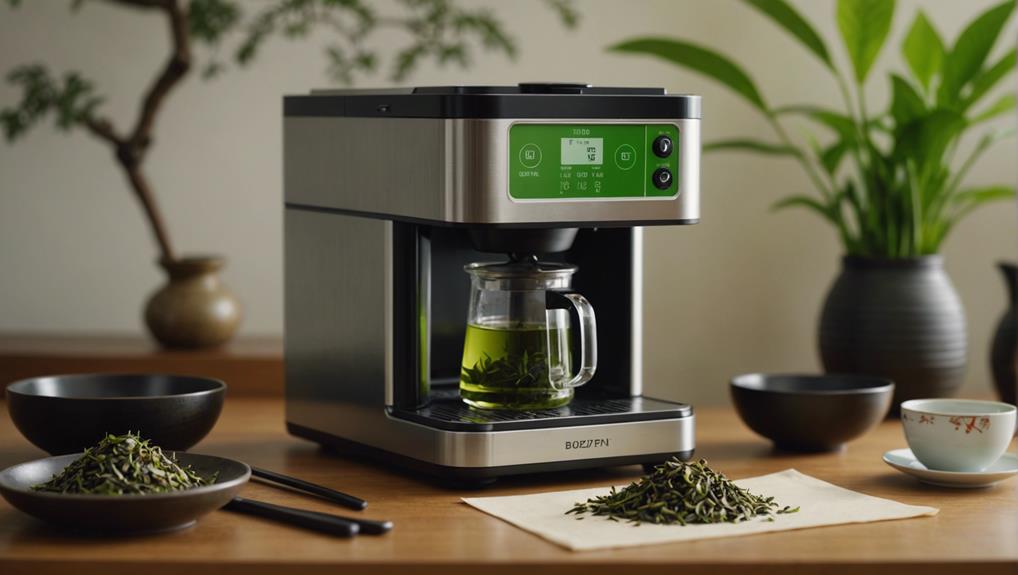
Tea's historical roots can be traced back thousands of years, originating in China and spreading to different parts of the world.
Understanding tea's cultural significance provides insights into its rituals, ceremonies, and social roles within various societies.
The global influence of tea has shaped economies, trade routes, and cultural exchanges across continents.
Tea's Historical Roots
Historically, the origins of tea can be traced back to ancient China, where it's believed to have been discovered accidentally by Emperor Shen Nong. This discovery dates back to around 2737 BCE.
Tea has since evolved, with modern twists in processing methods and flavors. The traditional Chinese legend credits the discovery of tea to Shen Nong, known as the 'Divine Healer.' The story goes that while boiling water in the garden, a leaf from a nearby Camellia sinensis plant fell into his pot, creating the first infusion of tea.
From these humble beginnings, tea has become one of the most widely consumed beverages worldwide. Its historical origins in China have laid the foundation for the diverse range of teas enjoyed today.
Tea's Cultural Significance
With its roots dating back to ancient China, tea's cultural significance is deeply intertwined with rituals, traditions, and social customs. Cultural traditions surrounding tea vary across different regions and have been passed down through generations.
In many Asian countries, tea ceremonies are a symbol of hospitality, respect, and tranquility. These ceremonies often involve precise movements and specific etiquette, reflecting the values of harmony and mindfulness.
Tea's cultural significance extends beyond ceremonies; it's a common social beverage that brings people together for conversations and bonding. Additionally, the health benefits associated with tea consumption have contributed to its cultural importance, with many viewing tea as a remedy for various ailments and a promoter of overall well-being.
Tea's Global Influence
Originating in ancient China, the global influence of tea can be traced back to its beginnings as a revered beverage with profound cultural significance. Tea ceremonies, steeped in tradition and symbolism, played a pivotal role in shaping the social fabric of various societies.
As tea's popularity spread, so did the establishment of intricate rituals that accompanied its consumption. The tea trade further propelled its influence, fostering economic ties between nations and facilitating cultural exchanges. Through the exchange of tea, different customs and practices were shared, enriching global interactions and fostering a sense of unity among diverse cultures.
The global reach of tea not only satisfied palates but also served as a bridge connecting people from distant lands, transcending borders and fostering a sense of camaraderie.
Green Tea Varieties
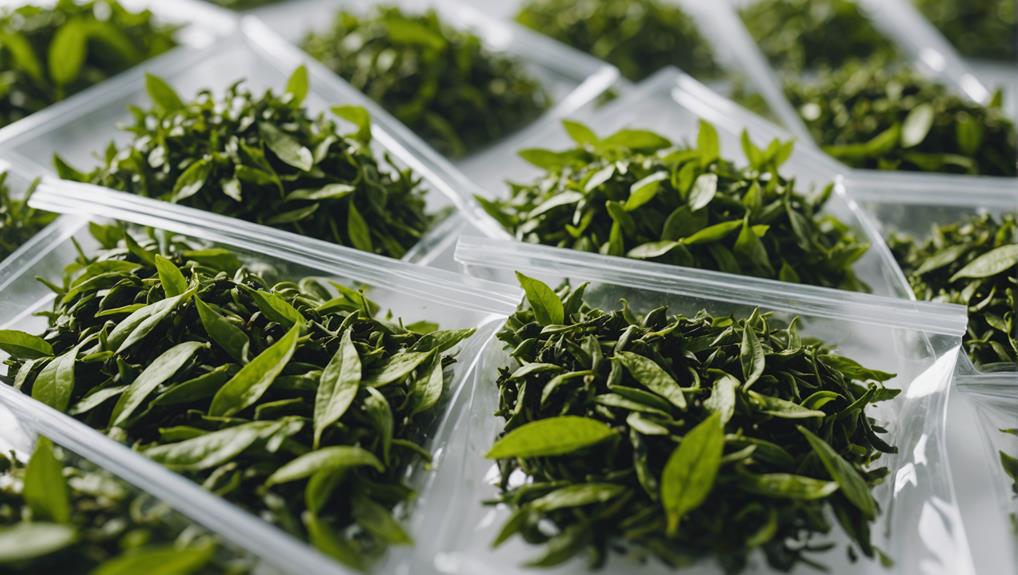
Among the various green tea varieties available, understanding the differences in processing methods is crucial for selecting the most suitable option to align with your preferences. Green tea comes in a myriad of types, each with its unique characteristics derived from processing techniques that influence taste, aroma, and color.
Here are some key points to take into account:
- Sencha: A popular Japanese green tea with a grassy flavor and a vibrant green color.
- Dragon Well (Longjing): A Chinese green tea known for its chestnut-like flavor and flattened leaves.
- Matcha: A finely ground green tea powder with a rich umami taste and vibrant green hue.
- Gunpowder: A tightly rolled Chinese green tea that unfurls during brewing, offering a bold flavor.
- Genmaicha: A Japanese green tea combined with roasted brown rice, providing a nutty flavor and a hint of sweetness.
Exploring these varieties will enable you to uncover the nuances in flavor profiles and find the perfect green tea to align with your preferences.
Matcha Tea Delights
You can explore the delightful world of matcha tea treats with Matcha Infused Tofu Delight, Green Tea Ice Cream, and Green Tea Custard Tart.
These delectable creations offer a unique way to experience the rich flavors of green tea in a variety of sweet dishes.
Each dish showcases the versatility of matcha and its ability to elevate traditional desserts with a touch of sophistication and a burst of vibrant green tea essence.
Matcha Infused Tofu Delight
A delectable fusion of matcha tea and tofu creates a culinary masterpiece known as Matcha Infused Tofu Delight. When combining the earthy undertones of tofu with the vibrant and slightly bitter notes of matcha, a harmonious blend of flavors emerges. Here are five reasons why Matcha Infused Tofu Delight is a must-try dish:
- Rich in Antioxidants: Matcha tea infusion adds a powerful antioxidant boost to the tofu, promoting health and well-being.
- Unique Texture: The matcha infusion enhances the texture of the tofu, creating a creamy and velvety consistency.
- Balanced Flavors: The subtle bitterness of matcha balances perfectly with the mild flavors of tofu.
- Versatile Dish: Matcha Infused Tofu Delight can be enjoyed on its own or incorporated into various recipes.
- Easy Preparation: This dish is simple to make, providing a quick and tasty tofu recipe option.
Green Tea Ice Cream
Green Tea Ice Cream, also known as Matcha Tea Delights, offers a rejuvenating and indulgent twist on traditional ice cream flavors. When it comes to green tea desserts, this creamy treat stands out for its unique taste and vibrant color. Explore the world of ice cream variations with Matcha Tea Delights and experience a new level of satisfaction.
Here are some reasons why you should try this delightful dessert:
- Rich in antioxidants, making it a healthier dessert option
- Unique earthy and slightly bitter flavor profile
- Creamy texture that melts in your mouth
- Perfect balance of sweetness and green tea essence
- Versatile ingredient for creative dessert recipes
Green Tea Custard Tart
Indulge in the intricate blend of matcha tea and creamy custard with the Green Tea Custard Tart from Matcha Tea Delights.
- Tea Inspired Recipes: Explore the fusion of traditional custard tarts with the aromatic essence of matcha tea.
- Creative Presentation: Discover a visually stunning dessert with a vibrant green hue that captivates the eyes before delighting the taste buds.
- Health Benefits: Benefit from the antioxidant properties of matcha tea, known for its potential to boost immunity and promote overall well-being.
- Unique Flavor Profile: Experience a harmonious marriage of earthy matcha and rich custard, creating a flavor sensation that's both familiar and intriguing.
- Perfect Harmony: Savor the balance between the slight bitterness of matcha and the subtle sweetness of custard in every decadent bite.
Tea-Infused Sous Vide Techniques
Tea-infused sous vide techniques offer a unique way to infuse your dishes with the flavorful essence of tea. By utilizing precision temperature control, you can extract the best taste from the tea leaves, ensuring a consistent and well-balanced infusion.
This method enhances the aromatic profile of your dishes, elevating the overall sensory experience for you and your guests.
Flavorful Tea Infusion
To enhance the infusion of flavors in sous vide cooking, consider experimenting with different tea varieties for a nuanced and invigorating culinary experience. Tea not only adds depth to dishes but also brings health benefits and floral notes to the table. Below is a table showcasing some popular tea varieties and their unique flavor profiles:
| Tea Variety | Flavor Profile | Best Used With |
|---|---|---|
| Green Tea | Fresh, grassy | Fish, chicken |
| Earl Grey | Citrusy, floral | Desserts, poultry |
| Chamomile | Light, apple-like | Pork, vegetables |
| Hibiscus | Tart, cranberry | Seafood, salads |
| Peppermint | Invigorating, minty | Lamb, chocolate desserts |
Experiment with these teas to elevate your sous vide dishes with a burst of flavor and aroma.
Precision Temperature Control
For enhanced precision in tea-infused sous vide techniques, maintaining a consistent temperature throughout the cooking process is essential to achieving the best flavor extraction and infusion.
Temperature accuracy directly impacts taste enhancement, ensuring that the delicate flavors of green tea are preserved and extracted optimally. Cooking precision in sous vide guarantees that the tea leaves are infused evenly, resulting in a harmonious blend of flavors.
Enhanced Aromatic Profile
Achieving an enhanced aromatic profile in sous vide green tea involves optimizing the infusion process to elevate the tea's sensory experience. To enhance the aromatic infusion, consider experimenting with different temperatures and infusion times.
Culinary experimentation with green tea in sous vide allows for precise control over the extraction of flavors from the tea leaves. By adjusting the temperature and duration of the sous vide process, you can tailor the aromatic profile to your preferences.
Keep in mind that the most suitable infusion time and temperature may vary depending on the type of green tea used. Through careful experimentation and attention to detail, you can access a richer, more complex aromatic profile in your sous vide green tea, enhancing your overall tea-drinking experience.
Final Thoughts
In conclusion, the efficacy of incorporating green tea into sous vide cooking methods showcases its potential to elevate culinary experiences with enhanced flavors and nutritional benefits. When considering sous vide benefits, the infusion techniques used with green tea can provide a unique opportunity to extract a myriad of compounds that contribute to both the taste and health properties of the final dish. The controlled temperature and prolonged cooking times in sous vide allow for a gentle extraction of flavors from the green tea leaves, resulting in a more delicate and nuanced profile compared to traditional brewing methods.
Furthermore, the sous vide method guarantees that the delicate compounds in green tea are preserved, offering a more pronounced taste and potential health benefits. By infusing green tea into various dishes using sous vide, you have the freedom to experiment with different flavors and create innovative culinary experiences that cater to your preferences. Overall, incorporating green tea into sous vide cooking can open up a world of possibilities for enhancing your dishes with a healthy and aromatic twist.
Frequently Asked Questions
Can Sous Vide Green Tea Be Used in Cocktails?
Yes, green tea cocktails can benefit from the infusion of sous vide techniques. By sous viding green tea, you can achieve precise flavor extraction and infusion for a more controlled and nuanced mixology experience.
Are There Any Health Benefits Specific to Sous Vide Green Tea?
You can experience enhanced antioxidant benefits through flavor infusion techniques like sous vide. This method optimizes extraction of health-promoting compounds from green tea. By infusing flavors at precise temperatures, you can maximize the health perks.
Can You Reuse the Green Tea Leaves After Sous Vide Infusion?
You can absolutely reuse green tea leaves after sous vide infusion. Consider tea composting for sustainability or explore tea art by recycling the leaves in creative ways. Embrace the versatility of tea beyond the initial infusion.
How Does the Sous Vide Method Affect Green Tea's Caffeine Content?
When sous vide green tea, the temperature impact can influence caffeine extraction. Higher temperatures may lead to increased caffeine levels, potentially resulting in a stronger brew. Experiment with different settings to achieve your desired caffeine content.
Are There Any Specific Temperature Recommendations for Sous Vide Green Tea?
For ideal flavor profiles and tea quality, specific water temperatures and brewing times are essential. Experiment with various temperatures to enhance or mellow the taste. Tea quality impacts the outcome greatly.
Conclusion
To sum up, incorporating green tea into sous vide cooking opens up a world of possibilities for enhancing flavors and infusing dishes with unique and aromatic notes.
By understanding the origins of tea, the varieties available, and the techniques for using matcha in cooking, you can elevate your culinary creations to a whole new level.
Experimenting with tea-infused sous vide techniques can lead to innovative and delicious results that will impress even the most discerning palates.
